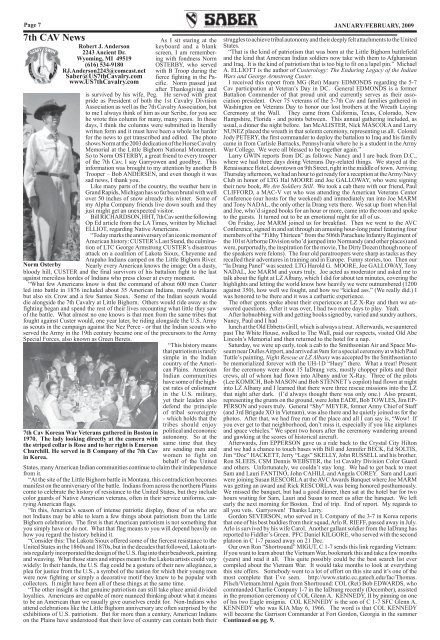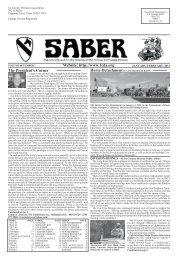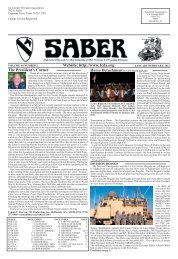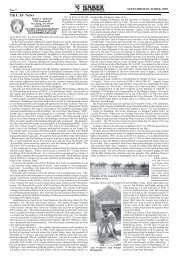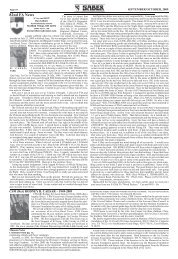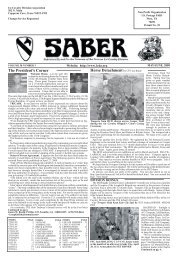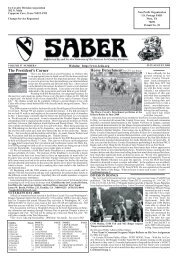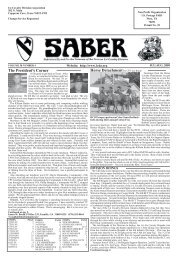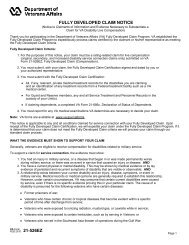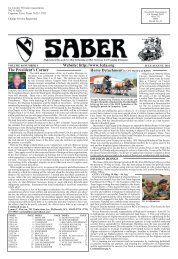Jan Feb '09 Saber.indd - First Cavalry Division Association
Jan Feb '09 Saber.indd - First Cavalry Division Association
Jan Feb '09 Saber.indd - First Cavalry Division Association
- No tags were found...
You also want an ePaper? Increase the reach of your titles
YUMPU automatically turns print PDFs into web optimized ePapers that Google loves.
Page 77th CAV NewsRobert J. Anderson2243 Ancient Dr.Wyoming, MI 49519(616) 534-9180RJ.Anderson2243@comcast.net<strong>Saber</strong>@US7th<strong>Cavalry</strong>.comwww.US7th<strong>Cavalry</strong>.comAs I sit staring at thekeyboard and a blankscreen, I am rememberingwith fondness NormOSTERBY, who servedwith B Troop during thefierce fighting in the Pacific.Norm passed justafter Thanksgiving andis survived by his wife, Peg. He served with greatpride as President of both the 1st <strong>Cavalry</strong> <strong>Division</strong><strong>Association</strong> as well as the 7th <strong>Cavalry</strong> <strong>Association</strong>, butto me I always think of him as our Scribe, for you seehe wrote this column for many, many years. In thosedays, I think the columns were submitted in literallywritten form and it must have been a whole lot harderfor the news to get transcribed and edited. The photoshows Norm at the 2003 dedication of the Horse <strong>Cavalry</strong>Memorial at the Little Bighorn National Monument.So to Norm OSTERBY, a great friend to every trooperof the 7th Cav, I say Garryowen and goodbye. Thisinformation was brought to my attention by another BTrooper – Bob ANDERSEN, and even though it wassad news, I thank you.Like many parts of the country, the weather here inGrand Rapids, Michigan has so far been brutal with wellover 50 inches of snow already this winter. Some ofmy Alpha Company friends live down south and theyjust might get an unexpected visitor.Bill RICHARDSON, HHT, 7th Cav sent the followingOp Ed article from the LA Times, written by MichaelELLIOT, regarding Native Americans.“Today marks the anniversary of an iconic moment ofAmerican history: CUSTER’s Last Stand, the culminationof LTC George Armstrong CUSTER’s disastrousattack on a coalition of Lakota Sioux, Cheyenne andArapaho Indians camped on the Little Bighorn River.Nearly every American knows the image: On a dusty,Norm Osterbybloody hill, CUSTER and the final survivors of his battalion fight to the lastagainst merciless hordes of Indians who press closer at every moment.“What few Americans know is that the command of about 600 men Custerled into battle in 1876 included about 35 American Indians, mostly Arikarasbut also six Crow and a few Santee Sioux. Some of the Indian scouts woulddie alongside the 7th <strong>Cavalry</strong> at Little Bighorn. Others would ride away as thefighting began and spend the rest of their lives recounting what little they sawof the battle. What almost no one knows is that men from the same tribes thatfought against Custer would, one year later, be riding alongside the U.S. Armyas scouts in the campaign against the Nez Perce - or that the Indian scouts whoserved the Army in the 19th century became one of the precursors to the ArmySpecial Forces, also known as Green Berets.“This history meansthat patriotism is rarelysimple in the Indiancountry of the AmericanPlains. AmericanIndian communitieshave some of the highestrates of enlistmentin the U.S. military,yet their leaders alsodefend the principleof tribal sovereignty- which holds that the7th Cav Korean War Veterans gathered in Boston in1970. The lady looking directly at the camera withthe striped collar is Rose and to her right is EmersonChurchill. He served in B Company of the 7th Cavin Korea.tribes should enjoypolitical and economicautonomy. So at thesame time that theyare sending men andwomen to fight onbehalf of the UnitedStates, many American Indian communities continue to claim their independencefrom it.“At the site of the Little Bighorn battle in Montana, this contradiction becomesmanifest on the anniversary of the battle. Indians from across the northern Plainscome to celebrate the history of resistance to the United States, but they includecolor guards of Native American veterans, often in their service uniforms, carryingAmerican flags.“In this, America’s season of intense patriotic display, those of us who arenot Indians may be able to learn a few things about patriotism from the LittleBighorn celebration. The first is that American patriotism is not something thatyou simply have or do not. What that flag means to you will depend heavily onhow you regard the history behind it.“Consider this: The Lakota Sioux offered some of the fiercest resistance to theUnited States in the 1860s and 1870s, but in the decades that followed, Lakota artistsregularly incorporated the design of the U.S. flag into their beadwork, paintingand weaving. What those stars and stripes meant to the Lakota artists could varywidely: In their hands, the U.S. flag could be a gesture of their new allegiance, aplea for justice from the U.S., a symbol of the nation for which their young menwere now fighting or simply a decorative motif they knew to be popular withcollectors. It might have been all of these things at the same time.“The other insight is that genuine patriotism can still take place amid dividedloyalties. Americans are capable of more nuanced thinking about what it meansto be an American than we usually give ourselves credit for. Non-Indians whoattend celebrations like the Little Bighorn anniversary are often surprised by theexhibitions of U.S. patriotism. But for more than a century, American Indianson the Plains have understood that their love of country can contain both theirJANUARY/FEBRUARY, 2009struggles to achieve tribal autonomy and their deeply felt attachments to the UnitedStates.“That is the kind of patriotism that was born at the Little Bighorn battlefieldand the kind that American Indian soldiers now take with them to Afghanistanand Iraq. It is the kind of patriotism that is too big to fit on a lapel pin.” MichaelA. ELLIOTT is the author of Custerology: The Enduring Legacy of the IndianWars and George Armstrong Custer.I received this report from MG (Ret) Maury EDMONDS regarding the 5-7Cav participation at Veteran’s Day in DC. General EDMONDS is a formerBattalion Commander of that proud unit and currently serves as their associationpresident. Over 75 veterans of the 5-7th Cav and families gathered inWashington on Veterans Day to honor our lost brothers at the Wreath LayingCeremony at the Wall. They came from California, Texas, Colorado, NewHampshire, Florida - and points between. This annual gathering included, asusual, a dinner the night before. Ian McALISTER, Nick MASCOLA and LarryNUNEZ placed the wreath in that solemn ceremony, representing us all. ColonelJody PETERY, the first commander to deploy the battalion to Iraq and his familycame in from Carlisle Barracks, Pennsylvania where he is a student in the ArmyWar College. We were all blessed to be together again.”Larry GWIN reports from DC as follows: Nancy and I are back from D.C.,where we had three days doing Veterans Day-related things. We stayed at theRenaissance Hotel, downtown on 9th Street, right in the middle of town. ArrivingThursday afternoon, we had an hour to get ready for a reception at the Army/NavyClub in honor of LTG Hal MOORE and Joe GALLOWAY, who were signingtheir new book, We Are Soldiers Still. We took a cab there with our friend, PaulCLIFFORD, a MAC-V vet who was attending the American Veterans CenterConference (our hosts for the weekend) and immediately ran into Joe MARMand Tony NADAL, the only other Ia Drang vets there. We sat up front when Haland Joe, who’d signed books for an hour or more, came into the room and spoketo the guests. It turned out to be an emotional night for all of us.On Friday, Joe MARM joined us for breakfast. Then we went to the AVCConference, signed in and sat through an amusing hour-long panel featuring fourmembers of the “Filthy Thirteen” from the 506th Parachute Infantry Regiment ofthe 101st Airborne <strong>Division</strong> who’d jumped into Normandy (and other places) andwere, purportedly, the inspiration for the movie, The Dirty Dozen (though none ofthe speakers were felons). The four old paratroopers were sharp as tacks as theyrecalled their adventures in training and in Europe. Funny stories, too. Then our“Ia Drang Panel” was seated: LTG Harold G. MOORE, Joe GALLOWAY, TonyNADAL, Joe MARM and yours truly. Joe acted as moderator and asked me totalk about the fight at LZ Albany, which I did for about ten minutes, covering thehighlights and letting the world know how heavily we were outnumbered (1200against 350), how well we fought, and how we “kicked ass.” (We really did.) Iwas honored to be there and it was a cathartic experience.The other gents spoke about their experiences at LZ X-Ray and then we answeredquestions. After it was over, I had two more days to play. Yeah.After hobnobbing with and getting books signed by, varied and sundry authors,Nancy, Paul and I hadlunch at the Old Ebbetts Grill, which is always a treat. Afterwards, we saunteredpast The White House, walked to The Wall, paid our respects, visited Old AbeLincoln’s Memorial and then returned to the hotel for a nap.Saturday, we were up early, took a cab to the Smithsonian Air and Space Museumnear Dulles Airport, and arrived at 9am for a special ceremony at which PaulTuttle’s painting, Night Rescue at LZ Albany was accepted by the Smithsonian tobe memorialized forever with the UH-1D “Huey” there. What a treat! Presentfor the ceremony were about 15 IaDrang vets, mostly chopper pilots and theircrews, all of whom had flown into Albany and/or X-Ray. Three of the pilots(Lee KOMICH, Bob MASON and Bob STENNET’s copilot) had flown at nightinto LZ Albany and I learned that there were three rescue missions into the LZthat night after dark. (I’d always thought there was only one.) Also present,representing the grunts on the ground, were John EADE, Bob TOWLES, Jim EP-PERSON and yours truly. General “Shy” MEYER, former Army Chief of Staff(and 3rd Brigade XO in Vietnam), was also there and he quietly joined us for thephotos. After that, we had free run of the place and all I can say is, “Wow! Ifyou ever get to that neighborhood, don’t miss it, especially if you like airplanesand space vehicles.” We spent two hours after the ceremony wandering aroundand gawking at the scores of historical aircraft.Afterwards, Jim EPPERSON gave us a ride back to the Crystal City Hiltonand we had a chance to touch bases with Bill and Jennifer BECK, Ed SOLTIS,Jim “Doc” HACKETT, Jerry “Legs” SKELLY, John RUSSELL and his brother,Ron SLEEIS, CSM Dennis WEBSTER, the 1st <strong>Cavalry</strong> <strong>Division</strong> Color Guardand others. Unfortunately, we couldn’t stay long. We had to get back to meetSam and Lauri FANTINO, John CAHILL and Angela COREY. Sam and Lauriwere joining Susan RESCORLA at the AVC Awards Banquet where Joe MARMwas getting an award and Rick RESCORLA was being honored posthumously.We missed the banquet, but had a good dinner, then sat at the hotel bar for twohours waiting for Sam, Lauri and Susan to meet us after the banquet. We leftearly the next morning for Boston. End of trip. End of report. My regards toall you vets. Garryowen! Thanks Larry.Gordon SEVERSON, who served in L Company of the 3-7 in Korea reportsthat one of his best buddies from their squad, Arlo R. RIEFF, passed away in July.Arlo is survived by his wife Carol. Another gallant soldier from the IaDrang hasreported to Fiddler’s Green. PFC Daniel KILGORE, who served with the secondplatoon in C 1-7 passed away on 21 Dec.Our own Ron “Shortround” MIGUT, C 1-7 sends this link regarding Vietnam:If you want to learn about the Vietnam War, bookmark this and take a few months(years) and read it all. This quite possibly could be the best search list evercompiled about the Vietnam War. It would take months to look at everythingthis site offers. Somebody went to a lot of effort on this site and it’s one of themost complete that I’ve seen. http://www.static.cc.gatech.edu/fac/Thomas.Pilsch/Vietnam.html Again from Shortround: COL (Ret) Bob EDWARDS, whocommanded Charlie Company 1-7 in the IaDrang recently (December), assistedin the promotion ceremony of COL Glenn A. KENNEDY, II by pinning on oneof his two Eagle insignia. COL KENNEDY is the son of C 1-7 SFC Glenn A.KENNEDY who was KIA May 6, 1966. The word is that COL KENNEDYwill become the Garrison Commander at Fort Gordon, Georgia in the summerContinued on pg. 9.


